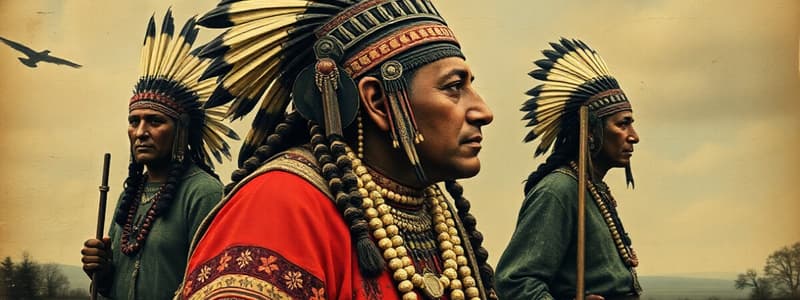Podcast
Questions and Answers
What was the primary purpose of establishing clans within the Iroquois Confederacy?
What was the primary purpose of establishing clans within the Iroquois Confederacy?
- To establish a system of governance based on lineage.
- To ensure peace and unity among the nations. (correct)
- To create a hierarchy among the nations.
- To promote trade and commerce between nations.
How did the Iroquois clan system influence family structures?
How did the Iroquois clan system influence family structures?
- Husbands moved into their wives' longhouses, signifying the importance of matrilineal descent. (correct)
- Clan membership was determined by a person's skills and abilities, regardless of their family background.
- Families within a clan lived separately in different longhouses, fostering a sense of independence.
- Children inherited their clan affiliation from their fathers.
Which of the following statements accurately describes the role of clans in Iroquois society?
Which of the following statements accurately describes the role of clans in Iroquois society?
- Clan membership was fluid and could be changed based on individual preferences, allowing for a dynamic social structure.
- Clans were named after animals, signifying the importance of nature and its influence on Iroquois culture. (correct)
- Clans were formed primarily based on shared religious beliefs, promoting spiritual unity within the Confederacy.
- Clan members were expected to marry within their own clan to maintain the purity of bloodlines.
How did the clan system help establish a sense of community among the Iroquois?
How did the clan system help establish a sense of community among the Iroquois?
What is the significance of the graphic's visual representation of clans and nations?
What is the significance of the graphic's visual representation of clans and nations?
Which of the following is NOT a characteristic of clan relationships within the Iroquois Confederacy?
Which of the following is NOT a characteristic of clan relationships within the Iroquois Confederacy?
What does the statement "The Peacemaker set up Iroquois society as matrilineal" mean?
What does the statement "The Peacemaker set up Iroquois society as matrilineal" mean?
Why were clans named after animals, such as wolf, bear, turtle, snipe, deer, beaver, heron, hawk, and eel?
Why were clans named after animals, such as wolf, bear, turtle, snipe, deer, beaver, heron, hawk, and eel?
Flashcards
Iroquois Confederacy
Iroquois Confederacy
A union of different nations united for mutual benefit and peace.
Clan System
Clan System
Organizational structure in Iroquois society based on family groups.
Matrilineal Society
Matrilineal Society
A system where lineage is traced through the mother's side.
Clan Names
Clan Names
Signup and view all the flashcards
Longhouse
Longhouse
Signup and view all the flashcards
Clan Hospitality
Clan Hospitality
Signup and view all the flashcards
No Inter-Clan Marriage
No Inter-Clan Marriage
Signup and view all the flashcards
The Peacemaker
The Peacemaker
Signup and view all the flashcards
Study Notes
Iroquois Clans
- The Iroquois Confederacy had a clan system that united the nations.
- Clans are still an important part of Iroquois identity today.
- Clans were named after animals (nine animals related to air, water, or land).
- Each clan was part of at least two nations, and three formed part of each nation.
- Iroquois society is matrilineal, tracing ancestry through the mother's side.
- Each clan has a common female ancestor.
- When people married, the husband moved into the wife's longhouse.
- Children belonged to their mother's clan.
- Clan members were considered family, even if from different nations.
- Clan members did not marry each other.
- Clan members lived together in longhouses.
- The graphic on the next page shows more information, including the Iroquois Museum in New York.
Studying That Suits You
Use AI to generate personalized quizzes and flashcards to suit your learning preferences.




